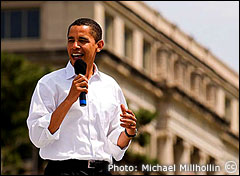In March 2007, Democratic primary contender John Edwards released an ambitious climate and energy plan, calling for greenhouse gas reductions of 80 percent by 2050, a cap-and-trade program with auctioned permits, and a ban on conventional dirty coal plants.

At that point in the race, conventional wisdom was that Edwards was trying to stake out the left and Hillary was going for the center — leaving Obama either nowhere to go, if you saw it like your average corpulent Democratic consultant, or free to maneuver, if you saw it like Obama. After Edwards released his plan, the obvious political move for a guy with his eye on the general election would have been for Obama to put out a somewhat more conservative version, to polish his centrist bona fides.
He didn’t, though. His plan, released in October, was more detailed and politically astute than Edwards’, but every bit as visionary. It proposes a declining carbon cap with fully auctioned permits, massive investments in energy research, job training, infrastructure, and efficiency, a renewable portfolio standard, a low-carbon fuel standard, higher fuel economy standards, and so on and on, in great detail. It is marred by its lavish support for biofuels and "clean coal," but that is a minor flaw in light of the historic changes it would spark if fully implemented.
Will it be fully implemented? In trying to figure out what Obama will do, it’s helpful to contemplate how he navigated the campaign itself.
The overall campaign strategy was to play the long game, to proceed steadily toward big targets and not get flustered or distracted by the day-to-day news cycle. No-drama Obama.
After the primary was over (and gas prices spiked, and a financial crisis struck), Obama did what polling indicated: he played down the parts of his plan that threaten to raise energy prices and played up investments in clean technology and green jobs. It’s a message that resonates across ideological and institutional lines. He was careful never to take sides in ecumenical energy debates: Nuclear is fine, if safe. Coal is fine, if the carbon is sequestered. Liquid coal is fine if it comes out of a low-carbon lifecycle. Offshore drilling is fine in exchange for serious support for renewables. What matters is not this or that energy source but the outcome, a cleaner economy.
This strategy allowed Obama to sound supportive of extractive and energy-intensive industries clustered in swing states while campaigning on an agenda that would utterly transform them. It allowed him the rhetorical space to refashion clean energy as a bread-and-butter jobs issue. It protected him from attacks on his right flank.
He never backed off his original proposals, though. The very day before the election he got attacked for telling the truth to a San Francisco newspaper. In the end, he was elected with a clear mandate for clean energy.
Now everyone wants to know what he’ll do. It’s seems reasonable to expect that he’ll stick with what seems to be his instinctive strategy: focus on the long game.
What’s that mean? For the Obama presidency, there are three biggies:
- Get out of Iraq.
- Do something about energy and carbon.
- Pass healthcare reform.
Based on precedent it’s likely he’d be willing to negotiate or horse trade just about anything else in favor of tackling these three issues.
Now, how does that same strategy translate to climate/energy? The biggies in this area are:
- A declining cap on carbon — the linchpin.
- Large investments in green R&D and infrastructure.
- Regulatory and tax support for clean electricity and alternative fuels.
The first two shape the foundation of the market and the third accelerates new industries within it.
Along the way, there are certain to be environmentalist-irritating concessions. There will be research and pilot-project funding for "clean coal," oil shale, and liquid coal. Ethanol subsidies are unlikely to be substantially curtailed. There will likely be more oil drilling. Horses will be traded.
The key is the long game. Obama worked carefully, diligently, and adeptly to get elected on a clean energy agenda. Despite the many reasons he gave greens to recoil along the way, he got there. There is every reason to believe he will now work carefully, diligently, and adeptly to get clean energy flowing to the country. That is in his best interest and the country’s.
Greens are deeply accustomed to believing that politicians are humoring them and will abandon their concerns at the first sign of lobbying. It’s not an unfounded fear, but it occasionally gives them the tone of jealous, paranoid lovers, flipping out over every perceived slight. Sometimes, though, what looks like a Sign He Doesn’t Really Mean It from one angle looks like long-term strategic thinking from another. Throughout the campaign Obama has repeatedly shown that his critics miss the difference. Perhaps, at least for a short while, Obama has earned the presumption of good faith.

